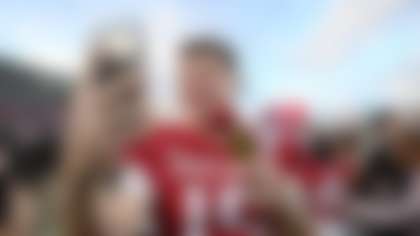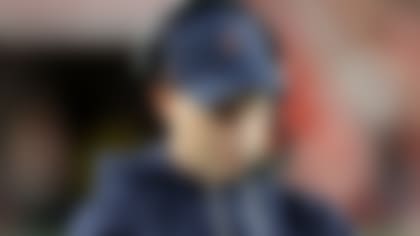Molly Delaney's day job is as an NFL associate labor relations counsel, a lawyer working for the group that represents the NFL in collective bargaining negotiations with the players' association. At this time last year, a new agreement was being negotiated. Then, when the COVID-19 pandemic changed practically everything about how the season would work in 2020, another agreement had to be struck. Late in the summer, as players finally gathered for training camp, the management council was focused on implementing the lengthy health and safety protocols designed to protect players, coaches and staff -- and the schedule of games -- from the ravages of the virus.
And suddenly Delaney had an entirely new job.
"It has been one thing after another," she said this week.
Delaney became one of the league's 18 contact tracers -- culled from the ranks of those who worked in other capacities, among them the management council (like Delaney) and football operations -- charged with doing the sleuthing after a team member tests positive for the virus to determine who an infected person was near and what he was doing. From the moment the NFL unveiled its protocols just before camps opened, it acknowledged they were not designed to prevent all infections -- that would be impossible because teams would not be in a bubble for the seven months of the season. Instead, the protocols were designed to limit the spread of the virus, to avoid outbreaks that would not just be potentially devastating to the health of team members and those close to them, but could have upended the schedule and derailed the season.
"It's absolutely foundational to the principle of avoiding transmission within a team," said Dr. Allen Sills, the NFL's chief medical officer. "Being able to do that with a high degree of precision -- it keeps people who might turn positive out of the team environment and it keeps the risk of infected individuals to the most reasonable level."
The NFL built its contact tracing system from scratch and somewhat on the fly, starting in the spring and adding people and resources all the way into the early part of the season, when infections inside facilities started to show up after there were so few positive tests during training camp that it surprised even league and union officials. Contact tracers were trained and, within a week, a system was in place – one that has continued through nights, weekends and, in recent weeks, holidays.
The league receives complete test results from the previous day's tests overnight. Infected people are isolated, and an early morning conference call that includes, among others, Sills, epidemiologists, contact tracers and representatives of football operations and player health and safety teams sets the contact tracing in motion.
They look at the background of every positive case – what position group is the player in, who else has been positive, has there been a virus signal inside the facility before the positive test. Contact tracing teams are formed and, along with an infectious disease expert and a team's infection control officer -- every team has had one this season, often the head athletic trainer -- they look at the team's schedule, whether they were traveling, what their itineraries were, what their hotel blocks looked like, who rode on which bus. They look at the data from Kinexon devices that every person must wear inside the facility and during games, that track who was near an infected person and for how long. They look at practice footage and security video to see who spent time together, and how close they were and whether masks were worn. And they do interviews -- of the person who tested positive and also people they were most in contact with. To do all the tracing and write the report for Sills' review that identifies who were high-risk close contacts and who might merit continued monitoring can take a few hours or a full day, depending on the circumstances. If a player tested positive on a game day, there is much more contact to be traced. If players were not in the building, as most are not on Mondays and Tuesdays, there is less contact and the tracing goes more quickly. If there are multiple positives on a team on the same day, the tracing is likely to take all day. Delaney said she has worked on cases for every team.
The tracing has not been without some obstacles. When contact tracers went to work on the Denver Broncos after backup quarterback Jeff Driskel tested positive in November, for instance, the quarterbacks were not forthcoming during interviews with contact tracers, according to an NFL official familiar with the process.
Delaney, who could not reveal specifics of the cases she has worked on because of privacy concerns, said generally there has been cooperation.
"The players and staff are just finding out they're positive -- it's not a great day for anyone," Delaney said. "It becomes very apparent they want to protect teammates. They are very candid and want to get to the right place."
In recent weeks, contact tracing has been particularly scrutinized because of its fallout. In Denver, every quarterback was deemed a high risk close contact -- the quarterbacks did not always wear masks properly and were in close quarters while watching film -- and was ineligible to play in the Broncos' game the next day, forcing a practice squad wide receiver to take snaps. Contact tracing wiped out the entire New Orleans Saints’ running back corps after Alvin Kamara tested positive, and a chunk of the Detroit Lions coaching staff, including interim head coach Darrell Bevell, for games.
In the last week, contact tracing has been vital in Cleveland, where the Browns have had positive tests among players and coaches, including head coach Kevin Stefanski, who will miss the Browns' playoff game Sunday night against the Steelers. Genomic sequencing has indicated that some individuals could have transmitted the virus to each other through team activities, Sills said, while other cases came from the community.
With contact tracing ongoing, the game remains on schedule.
"We feel at this point that we have a good handle on those transmission events," Sills said Wednesday. "New cases can come from the community every day. We look at one case as being a serious situation. We feel that we have a reasonable understanding of the transmission in this case."
Contact tracing has also revealed vulnerabilities that have informed the tweaks the NFL has made to its protocols all season and the advice it gives teams. In one case, Delaney said, contact tracers found that a lot of players carpool to work if they live far from the team facility. So the league told teams to make sure players had their own modes of transportation so they wouldn't be in a car for 40 minutes together.
"That was an easy one," Delaney said.
The protocols were changed during the season to require masking on sidelines during games when contact tracing of gameday contacts showed that the cumulative time players sit next to each other on the bench can add up. Masking added an extra layer of protection. When tracers noticed that players and staff had a lot of contact on team busses to and from stadium, and that time was adding up -- particularly because many players would remove masks to eat on the bus -- the league recommended that teams use more busses and some opposing teams even set up tables, so players could eat, appropriately distanced, before they got on the bus.
The biggest change came in mid-November, when, as the cases surged nationwide, the league put every team into its intensive protocols, meaning that all meetings were to be held virtually unless they could be held outdoors, masks must be worn at all times, including during practice, all meals must be served grab and go, so that there were no gatherings, and time in the locker room was limited. The league said there has been a 50 percent drop in close contacts since.
"We learned through tracing how teams operate," Delaney said.
Most importantly, the league said that, so far, 37 people who were identified as high-risk close contacts and were in a five-day isolation later tested positive.
"That's 37 cases we feel were prevented from coming into the team environment," Sills said. "Imagine the multiplication that could have occurred. That's one of the sentinel accomplishments of contact tracing."
It is unclear if and how contact tracing will be done during offseason programs. But for now, Sills has said that the protocols will not change during the playoffs, despite the possibility that a playoff team could find itself in a similar situation to the ones the Broncos and Saints were in during the regular season.
"I'd like to say I'm going to retire after the Super Bowl," Delaney said. "My goal is just to get to the Super Bowl."
Follow Judy Battista on Twitter.




